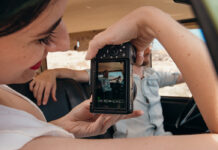
Nikon now has beta software you can use to turn select cameras into webcams when connected to your computer for video conferencing.
The move follows similar moves other brands have made over the course of the year, including GoPro, Panasonic, Fujifilm and Canon. The global pandemic and the increased need for video conferencing has spurred camera manufacturers to offer this kind of functionality. Nikon is just the latest to do it.
The advantage in doing it is that you benefit from the high-quality image DSLR and mirrorless cameras are capable of. Rather than buying a dedicated webcam, especially when using a larger monitor at a home office desk, the camera can play that role instead.
Which cameras does it support?
Nikon has made the Webcam Utility Beta software free to download—but it’s currently only for Windows 10 computers. There’s no word yet on when the company will release a Mac version. Double-check to ensure you have a PC running Windows 10 with a 64-bit version, as it’s required for compatibility.
As for the eligible cameras, Nikon has started with a decent foundation. For mirrorless cameras, the Z5, Z6, Z7 and Z50 are included. On the DSLR side, the D500, D780, D850, D5600 and D7500 are supported. None of the company’s CoolPix cameras are part of this, unfortunately.
You may also want to make sure your camera’s firmware is fully updated before you go ahead with this. To do that, you can follow this link and take the steps necessary to do that. It’s slightly different for mirrorless cameras and DSLRs, but should be quick and painless.
To use the webcam camera setup, you would first connect the camera to the computer via USB. After launching a video conferencing application, choose “Webcam Utility” as the output source and the camera’s video feed should appear.
Things to know about this setup
As part of the announcement, Nikon did note some usability and performance details to consider. The camera will get hot if you use it for an extended period, but does automatically shut off if the internal temperature gets too high. It’s also a drain on the camera’s battery, especially with live view on. And if you do try to use Webcam Utility with multiple video conferencing or live streaming apps, it will only work with one at a time.
The connection will disable the camera’s own settings while hooked up. If you do need to change anything, you would have to turn the camera off and disconnect the USB cable first. Then you could go into the settings, change what you need, and reconnect.
If you want the best video quality, you could utilize the Nikon camera’s HDMI port. However, this setup has a catch, which is that you would need a third-party capture device to pull it off. Among those Nikon mentions, the Elgato Cam Link and AverMedia ExtremeCap UVC are compatible with such a connection.
Learn more about the value of using your mirrorless or DSLR camera with your computer right here.



